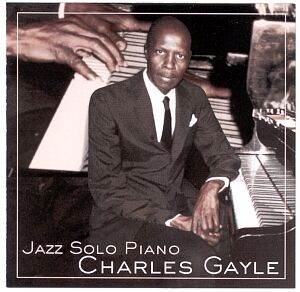CHARLES GAYLE
Jazz Solo Piano
 Knitting
Factory KFW 288
Knitting
Factory KFW 288

Although he is best known as a tenor saxophonist, Charles
Gayle’s first instrument was actually the piano. Largely self-taught,
he played only piano between the ages of nine and nineteen. (Incidentally,
he is also a powerhouse drummer. Witness his work in The Blue Humans.)
His saxophone playing has the fire and freedom reminiscent of late Coltrane,
combined with the sanctified possession of Albert Ayler, and might lead
one to expect something similar when he turns to piano; maybe long improvisations
similar to those of Cecil Taylor would be a fair guess.
But no, it would be largely impossible to identify
Gayle the pianist from knowing Gayle the saxophonist. At the piano,
Gayle is no modernist, having strong revivalist tendencies. He turns
out fourteen tracks, mainly standards, none longer than seven minutes,
most far shorter. Gayle claims that all are "inspired by the music
of the 1930s and 1940s". In fact, the music draws comparisons with
music from the 1920s to the present day. Pieces like "Afternoon
in Paris", "Cherokee", ""Body & Soul"
and "Softly as in a Morning Sunrise" are played relatively
straight, with clear statements of the melody lines, but subsequent
improvisations not always true to their mood or spirit. Two versions
of "I’ll Remember April" are each taken at a gallop. Gayle’s
own composition "1939" is entertaining, knockabout stuff that
could be the piano accompaniment to a silent comedy, complete with breathtaking
chase sequences, melodic romantic interludes, unexpected pratfalls and
slapstick.
Gayle’s playing style clearly has roots in 30s stride
piano, but it could never be mistaken for actual pre-war piano. It is
too knowingly aware of everything that has happened since, Thelonious
Monk in particular. However, Gayle does not have Monk’s sense of timing
or humour (who does?!) and his version of "Round Midnite"
is perfunctory. While Gayle more than once recalls Monk’s quirkiness,
too often he seems to dislike or distrust quiet and space, rushing pieces
along and filling every available gap with embellishment. (This album
is not Touchin’ on Monk, good as that title would have been.)
Coltrane’s "Countdown" is frantically paced and acts as an
opportunity for Gayle to demonstrate his technical proficiency, as he
fires off rapid runs and block chords. It is about as close to his sax
persona as Gayle gets here, but not very close.
Music from this album will doubtless be used in blindfold
tests for years; such is its power to confound expectations. This is
an interesting companion piece to Gayle’s sax albums, but no substitute
for them.
John Eyles